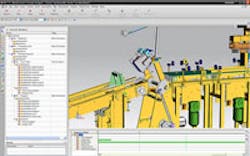Siemens Promises Development Time, Quality Improvements with New Design Software
Interactive simulation capability based on “gaming” technology simplifies developers’ tasks, reducing design development time.
Siemens PLM Software recently introduced a new integrated design solution for companies that develop and market machine tools and production machines. It calls Mechatronics Concept Designer™ a “paradigm shift” that brings a new systems engineering approach to machine design, incorporating customer input, managing early requirements and facilitating simultaneous definition and simulation of the complex mechanical, electrical and automation software typical in complex machine tools.
More intriguing, the program presents interactive simulation capability based on “gaming” technology, making it easy for developers to use, and thus reduce design development time. It means that end-users and machine developers can customize new machining centers more easily and quickly.
Siemens PLM is a business unit of the Siemens Industry Automation Division that develops product lifecycle management software and services. It introduced Mechatronics Concept Designer at IMTS 2010.
“Siemens PLM Software’s Mechatronics Concept Designer solution enables our entire development team to collaborate more effectively from the beginning to the end of the machine design process, thereby allowing us to catch and easily correct issues early, before they become costly manufacturing or customer related problems,” stated Dr.-Ing. Siegfried Schmalzried, managing director MAG Switzerland, MAG Industrial Automation Systems. “In addition, its ability to capture and support requirements, coupled with its outstanding physics simulation, gives us the confidence we are producing a very high quality design that will meet or exceed our customers’ expectations. And that’s a strong competitive edge.”
The new Mechatronics Concept Designer program works in conjunction with Siemens’ Teamcenter PLM system, simplifying the task of importing customer requirements from MS Word documents.
The design of machine tools involves experts from various disciplines (mechanical, electrical, and software design) to complete a complex machine to specific requirements of individual customers. “Standard software tools don’t take requirements into account,” Siemens PLM explains, “and the lack of a ‘common language’ has made it difficult for these disciplines to integrate with each other until the end of the design process when changes are more costly, both in time and money. This fragmented set of design applications combined with the complexity of the machines, has made it virtually impossible to simulate and evaluate various design concepts to support rapid and effective product development decision-making.”
Mechatronics Concept Designer makes it possible for mechanical, electrical, and software/automation disciplines to work in parallel. It combines the mechanical design features of Siemens’ NX CAD architecture but allows the user to develop a list of sensors and actuators that can be positioned easily to establish the basis for electrical engineers to create the layout. Even more efficient software development is supported through the ability to make the machine’s sequence of operations available in a standard format common in the machinery industry.
The new program also works in conjunction with Siemens’ Teamcenter PLM system to deliver complete machine design using an integrated, systems engineering approach: Designers can use the Teamcenter requirements management and systems engineering capabilities to build a functional model that ensures customer requirements are incorporated into the design.
Siemens latest machine design program makes it possible for mechanical, electrical, and software/automation disciplines to work in parallel. It combines the mechanical design features of CAD architecture but allows the user to develop a list of sensors and actuators that can be positioned easily to establish the basis for electrical engineers to create the layout.
“Machine tool builders must improve development methods that span from conceptual design through detailed design,” said Sal Spada, Research Director, ARC Advisory Group. “Specifically, development methods that facilitate conceptualization of a system early in the design process and track functional requirements with the implementation are essential to reducing time to market and ensuring that the completed system meets the customer expectations.”Mechatronics Concept Designer includes modeling and simulation capability based on NVIDIA® PhysX® technology. It’s a physics engine that’s similar to software used in many of video games, for what Siemens calls a “groundbreaking approach” to simulation. Design alternatives can be created, reviewed, and validated quickly and easily — and interactively. The users are able to interact with the digital machine model while the simulation is running, so they are able to test the effects of different inputs in real time. This is a process simplification that models actual physical behavior, so errors can be detected and corrected much more easily and cost-effectively.
“By providing the ability to simulate and validate complete concepts in a virtual environment we are not only helping our customers develop machines faster, we are also helping them design with more confidence and with a higher degree of quality,” according to Joan Hirsch, vice president of Product Design Solutions, Siemens PLM Software.
Related Articles
Siemens Aiming to Place Quality Management “in the Cloud”
Chrysler Taps Siemens PLM Software for Product Design, Development
